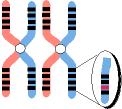| ESE424 : The Class : Students : Mental Retardation: Organic | |||||
Organic Causes of Mild Mental Retardation
The first major category of causes of mild mental retardation is referred to globally as organic factors. Prior to our recent explosion of knowledge about genes, chromosomes, and or renewed interest in disabilities, an older view of mental retardation held that that the majority of mild mental retardation was a result of a deficient environment. It was believed that factors in the environment (limited stimulation, poverty, lack of appropriate schooling) were responsible for mild mental retardation. While some forms of mild mental retardation probably do result from environmental deprivation (we still see children who have been locked in closets for considerable amounts of time), organic factors do play a part. Consider this:
- only 50% of mental retardation can be traced to an identifiable cause
- organic factors can be identified for only 60-70% of the cases of moderate to severe mental retardation
- only 25-40% of the cases of mild mental retardation have an identifiable cause
Given these facts, we can construct a model of mild mental retardation that would look like this:

Causes of Mild Mental Retardation
Click on each piece of the pie chart to see a distribution of more specific
factors
As you are able to see, it is important to remember that individuals with mild mental retardation may have an underlying organic disorder.
In this topic we will focus on learning about potential organic causes of mild mental retardation. These can be partitioned into three general groups:
- chromosomal abnormalities such as Down syndrome
- single gene defects like Fragile X syndrome
- congenital factors such as substance abuse and
For a breakdown on the percentages of specific organic causes, click on the link below:
 Chromosomal
Abnormalities
Chromosomal
Abnormalities
Chromosomal abnormalities a small contributor to the incidence of mild mental retardation. We will look first at some basic information about chromosomal abnormalities then at four specific chromosomal abnormalities that can produce mild mental retardation: Down, Klinefelter, Turner, and Prader-Willi syndromes.
Basic Information.
As you may remember from previous courses, humans have 23 pairs of chromosomes. These are divided into 22 pairs that are collectively referred to as autosomes. The autosomes contain the genes that are responsible for the expression of many of our traits (hair color, eye color, height, weight). The remaining pair, the sex chromosomes determine the sex of the person.
During cell division the chromosomes two daughter cells are produced as the chromosomes duplicate themselves. Duplication of the autosome cells is called mitosis. This process generally takes between 1-2 hours to complete. Cell division of sex chromosomes is called meiosis. Both mitosis and meiosis consist of a series of 5 predictable phases.
The preponderance of chromosomal abnormalities occur during meiosis.
Chromosomal abnormalities are verified by using a karyotype. Karyotypes are a photographic representation of the make up of a cell that display the number, type, form and size of chromosomes in a cell. Karyotypes typically are arranged in a diagram to ease in identifying chromosomal abnormalities.
You will have the opportunity to view karyotypes of the various conditions that are associated with mild mental retardation as we progress through this unit.
What can go wrong?
Several problems can occur during cell division and cause chromosomal abnormalities.
- deletions
- genetic material is lost during the duplication process as parts of chromosomes break off
- translocations
- parts of one chromosome are transferred to different chromosome (14/21 translocation)
- nondisjunctions (of sex or autosomes)
- cells divide unevenly such that one cell receives more or less than its normal complement of chromosomes (45 - one too few; 47 one too many). In almost all cases, the cell with fewer than the normal complement of chromosomes will not live (the exception is Turner syndrome).
- insertions
- a piece of genetic material is inserted into the normal chromosomal structure of another chromosome. This can result in duplications or deletions.
- inversions
- the genetic material one one or more chromosome is sequenced in an inverted manner
Types of chromosomal abnormalities
Specific Chromosomal Abnormalities
Down syndrome
Probably the most commonly cited chromosomal abnormality in mental retardation is Down syndrome. This condition effects between 5-6% of persons with mental retardation. Downs can be caused by a nondisjunction, a translocation, or by a process called mosaicism. Regardless of the process involved, the person has an extra 21st chromosome, called a trisomy (hence the more common medical name - trisomy 21). Persons with downs may have very mild or quite severe mental retardation. Most children with Downs function in the moderate range of mental retardation. In approximately 20-25% of the cases, maternal age is a factor. As maternal age increases, the incidence of Downs also increases from an initial 1:400 to 1:30 after 45 years of age.
Persons with Down syndrome have certain characteristics:
- short stature
- flat, broad face with small ears and noses
- short broad hands
- upward slanting of the eyes with small folds of skin at the near corner (by the nose)
- small oral cavities with a high arched palate
- a single crease on the palm of the hand (simian crease)
- increased chance of having reduced muscle tone
- increased susceptibility to upper respiratory infections
- increased probability of heart defects
For children with mild mental retardation, more often than not, the form of Downs that they have is called mosaic or mosaicism.
Mosaicism during cell division
More information about Down syndrome:
- View a karyotype of a person with Down syndrome
- Pictures of a child with Down syndrome
Klinefelter Syndrome
Klinefelter syndrome occurs from a nondisjunction of the sex chromosomes. The condition effects only males and results in an extra X chromosome (47 - XXY). The male produces an inadequate supply of the hormone testosterone and may not develop secondary sex characteristics. Persons with Klinefelter syndrome generally have IQ scores from low (mildly mentally retarded) to the average range of intellectual functioning.
- Klinefelter syndrome
- a karyotype of a person with Klinefelter syndrome
Turner Syndrome
Turner syndrome is a chromosomal abnormality involving nondisjunction that results in a cell with 45 chromosomes that effects only females. Effected individuals have only one X chromosome and no second X or Y mate. This is one the only chromosomal abnormalities where a cell with less than the normal complement of chromosomes survives. Geneticists estimate that 99% of the pregnancies that produce a Turner cell end in spontaneous abortion. Children with Turner syndrome are more likely to have mild mental retardation, learning disabilities, visual perceptual problems and heart problems.
More information about Turner syndrome:
- general information about the syndrome
- clinical abnormalities with Turner's
- karyotype of an individual with Turner's
- pictures of children with Turner's
Prader-Willi Syndrome
Prader-Willi is a syndrome caused by a partial deletion of the 15th chromosome. Frequently, a person with Prader-Willi will progress through two stages. In the first stage the child has low muscle tone and difficulty with eating (failure to thrive). The second stage begins at about 1-3 years of age and is characterized by insatiable appetite and obesity. Children with Prader-Willi syndrome typically have the following characteristics:
- short stature
- obesity
- mild mental retardation
- almond shaped eyes
- low muscle tone
- behavior problems
More information about Prader-Willi:
- basic facts about the syndrome
- diagnostic criteria
- frequently asked questions (FAQs)
- stories of children with Prader-Willi -
 Single
Gene Defects
Single
Gene Defects
The next major type of organic cause of mild mental retardation is a single gene defect. Any time a chromosome is damaged or malformed, the risk of a single gene defect increases significantly. Single gene defects cause the body to produce insufficient or excessive amounts of a protein, or none at all. Single gene defects can also effect the formation of a chromosome as in the case of Fragile X syndrome, which we will review shortly.
Single gene defects can be inherited in several ways.
- autosomal dominant transmission
- autosomal recessive transmission
- figure of autosomal dominant and recessive inheritance
- sex-linked dominant
- sex-linked recessive
- multifactoral
Fragile X Syndrome
Fragile X results from a single gene defect that results in a replication of a sequence of genes on the X chromosome. The replication sequence causes a fragile site on the X chromosome. The repetition can occur many times depending on the extent of the defect. More than 200 repetitions result in a "full mutation" and cause a more severe form of Fragile X (more typical in males). Males who have a full mutation often have more severe mental retardation. Females are effected differently: 33% have normal intelligence, 33% have average intelligence with a learning disability, and the final 33% have mild or more severe mental retardation.
- the fragile site on the X chromosome (scroll down about 1/3 of the page)
- cause
- prevalence
- symptoms
- inheritance
- children with Fragile X
- frequently asked questions about Fragile X
Congenital Factors
The final section of this lesson on organic factors of mild mental retardation covers congenital factors that include:
- teratogens
- maternal diseases and disorders
- substance abuse
Teratogens
Teratogens are agents in the environment that effect the developing embryo and fetus. Exposure to teratogenic agents can cause structural and functional abnormalities. About 8% of all birth defects can be traced to teratogens.
Several factors interact to mediate the effect of a teratogen:
- the timing of the exposure to the agent
- the genetic make up of the fertilized egg
- the genetic make up and environmental setting of the mother
- the type and dosage of the teratogen
In general, the effect of a teratogen is worst during the first 2 weeks of fetal life. During this time, exposure to many of these substances will result in a spontaneous abortion. Later exposure will result in disturbances in functioning of an organ but the general structure appears normal.
Some cases of exposure to teratogens have been related to cases of mild mental retardation. Specifically, lead poisoning. Although many houses use lead-free paints and the amount of lead in other common substances is decreasing, some feel that the amount of lead in pollution is increasing. Lead poisoning has been directly related to cases of mental retardation.
Maternal Diseases and Disorders
Maternal disease is another known cause of birth defects and other developmental problems including mild mental retardation. Maternal diseases such as rubella, syphilis, TORCH, and Rh incompatibility can have serious effects on the developing fetus. Click on the links below to learn more about the types of maternal diseases and disorders that can effect the fetus
Maternal infections
Maternal disorders
Substance Abuse
Another potential congenital source of mild mental retardation is substance abuse. Specifically, alcohol, cocaine are frequently cited in studies of mental retardation. Fetal exposure to either substance during early pregnancy, often when the mother does not know she is pregnant, can have problematic results for the developing central nervous system. Read about the effects of substance abuse on the link below.
Once you have completed this lesson, you should:
Go on to
Online Lesson 2: Environmental Causes
or
Go back to The Class
Page
E-mail the instructor at Larry.Gallagher@nau.edu
Web site created by the NAU OTLE Faculty Studio
Copyright 1998 Northern Arizona University
ALL RIGHTS RESERVED
